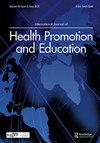Editorial viewpoint: promoting health through spatial planning for ‘health net gain’
IF 0.7
Q3 EDUCATION, SCIENTIFIC DISCIPLINES
International Journal of Health Promotion and Education
Pub Date : 2023-03-04
DOI:10.1080/14635240.2023.2175932
引用次数: 0
Abstract
The Ottawa Charter for Health Promotion recognised that health is created within the settings of everyday life, from homes and workplaces to our wider natural and built environments. The planning, design, and management of these environments significantly influences health and wellbeing (Chang, Petrokofsky, and Green 2022), and environmental changes present opportunities to create health-promoting settings, address health-damaging risks and reduce health inequalities. Environmental and health policies share principle-based approaches and objectives of protection and improvement. An ‘environmental net gain’ principle has been introduced in English spatial planning policy that requires new developments to deliver gains in biodiversity, using a metric based on characteristics of place. A mitigation hierarchy prioritises avoidance and minimisation of damage, which has obvious parallels with health protection hierarchies addressing threats such as air pollution and flooding. Gains necessitate measurable improvements, extending the comparison from specific risks, exposures and harms to broader concepts of health and opportunities to improve it. Realising sought-for gains requires long-term local commitments as well as strategic coordination. Planning obligations and covenants aim to secure biodiversity gains; here there are parallels with the provision of healthier environments and health promotion. The idea of a net gain principle for health in spatial planning raises many considerations, not least its role in addressing inequity and health inequalities and the place of health promotion integral to the realisation of health gains forecast by developers. This is an area of emerging interest and research (Stewart-Evans, Koksal, and Chang 2022; Koksal 2022) requiring the integrated multi-disciplinary approaches that underpin health promotion. Whilst reform of the planning system presents opportunities and challenges, considered input from public health practitioners remains fundamental to creating and realising opportunities to create health through our built and natural environments, places and settings.编辑观点:通过空间规划促进健康,实现"健康净收益"
《渥太华健康促进宪章》承认,健康是在日常生活环境中创造的,从家庭和工作场所到我们更广泛的自然和建筑环境。这些环境的规划、设计和管理对健康和福祉有重大影响(Chang、Petrokofsky和Green 2022),环境变化为创造促进健康的环境、解决损害健康的风险和减少健康不平等提供了机会。环境和卫生政策共享基于原则的方法和保护和改善的目标。在英国的空间规划政策中引入了“环境净收益”原则,该原则要求使用基于地点特征的度量来实现生物多样性的新发展。缓解等级优先考虑避免和尽量减少损害,这与解决空气污染和洪水等威胁的健康保护等级有明显的相似之处。取得的成果需要可衡量的改进,将比较从具体的风险、暴露和危害扩大到更广泛的健康概念和改善健康的机会。实现预期的收益需要长期的地方承诺和战略协调。规划义务和公约旨在确保生物多样性的收益;这与提供更健康的环境和促进健康有相似之处。空间规划中健康净收益原则的想法引起了许多考虑,尤其是它在解决不平等和健康不平等方面的作用,以及健康促进在实现开发商预测的健康收益中不可或缺的地位。这是一个新兴的兴趣和研究领域(Stewart-Evans, Koksal, and Chang 2022;(Koksal 2022),需要综合的多学科方法来支持健康促进。虽然规划系统的改革带来了机遇和挑战,但公共卫生从业人员经过深思熟虑的投入仍然是创造和实现通过我们的建筑和自然环境、场所和环境创造健康的机会的基础。
本文章由计算机程序翻译,如有差异,请以英文原文为准。
求助全文
约1分钟内获得全文
求助全文
来源期刊

International Journal of Health Promotion and Education
EDUCATION, SCIENTIFIC DISCIPLINES-
CiteScore
2.30
自引率
10.00%
发文量
69
 求助内容:
求助内容: 应助结果提醒方式:
应助结果提醒方式:


